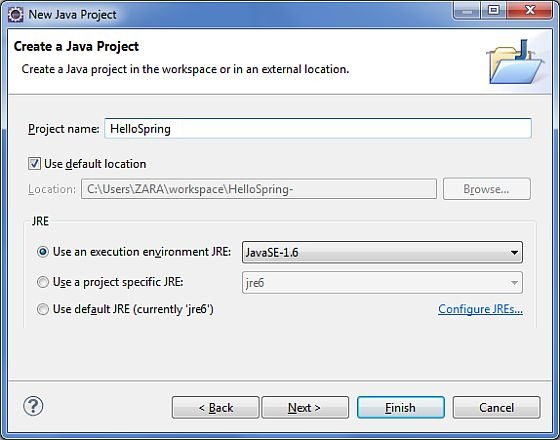Spring Hello World 实例
让我们使用 Spring 框架开始实际的编程。在你开始使用 Spring 框架编写第一个例子之前,你必须确保已经正确地设置了 Spring 环境,正如在 Spring——环境设置 教程中如所说的。假设你有了解一些有关 Eclipse IDE 工作的知识。
因此,让我们继续编写一个简单的 Spring 应用程序,它将根据在 Spring Beans 配置文件中配置的信息输出 “Hello World!” 或其他信息。
第 1 步:创建 Java 项目
第一步是使用 Eclipse IDE 创建一个简单的 Java 项目。按照选项 File -> New -> Project,最后从向导列表中选择 Java Project 向导。现在,使用向导窗口将你的项目命名为 HelloSpring,如下所示:

一旦你的项目创建成功后,将在 Project Explorer 看到下面的内容:

第 2 步:添加必需的库
第二步让我们添加 Spring 框架和通用的日志 API 库到我们的项目中。为了做到这个,在你的项目名称 HelloSpring 上单击右键,然后在快捷菜单上按照下面可用的选项:Build Path -> Configure Build Path 显示 Java 构建路径窗口,如下所示:

现在,在 Libraries 标签中使用可用的 Add External JARs 按钮,添加从 Spring 框架和通用日志安装目录下面的核心 JAR 文件:
commons-logging-1.1.1
spring-aop-4.1.6.RELEASE
spring-aspects-4.1.6.RELEASE
spring-beans-4.1.6.RELEASE
spring-context-4.1.6.RELEASE
spring-context-support-4.1.6.RELEASE
spring-core-4.1.6.RELEASE
spring-expression-4.1.6.RELEASE
spring-instrument-4.1.6.RELEASE
spring-instrument-tomcat-4.1.6.RELEASE
spring-jdbc-4.1.6.RELEASE
spring-jms-4.1.6.RELEASE
spring-messaging-4.1.6.RELEASE
spring-orm-4.1.6.RELEASE
spring-oxm-4.1.6.RELEASE
spring-test-4.1.6.RELEASE
spring-tx-4.1.6.RELEASE
spring-web-4.1.6.RELEASE
spring-webmvc-4.1.6.RELEASE
spring-webmvc-portlet-4.1.6.RELEASE
spring-websocket-4.1.6.RELEASE第 3 步:创建源文件
现在让我们在 HelloSpring 项目下创建实际的源文件。首先,我们需要创建一个名为 com.tutorialspoint 的包。在 package explore 区域中的 src 上点击右键,并按照选项:New -> Package。
接下来,我们在包 com.tutorialspoint 下创建 HelloWorld.java 和 MainApp.java 文件。

这里是 HelloWorld.java 文件的内容:
package com.tutorialspoint;
public class HelloWorld {
private String message;
public void setMessage(String message){
this.message = message;
}
public void getMessage(){
System.out.println("Your Message : " + message);
}
}下面是第二个文件 MainApp.java 的内容:
package com.tutorialspoint;
import org.springframework.context.ApplicationContext;
import org.springframework.context.support.ClassPathXmlApplicationContext;
public class MainApp {
public static void main(String[] args) {
ApplicationContext context =
new ClassPathXmlApplicationContext("Beans.xml");
HelloWorld obj = (HelloWorld) context.getBean("helloWorld");
obj.getMessage();
}
}关于主要程序有以下两个要点需要注意:
-
第一步是我们使用框架 API ClassPathXmlApplicationContext() 来创建应用程序的上下文。这个 API 加载 beans 的配置文件并最终基于所提供的 API,它处理创建并初始化所有的对象,即在配置文件中提到的 beans。
- 第二步是使用已创建的上下文的 getBean() 方法来获得所需的 bean。这个方法使用 bean 的 ID 返回一个最终可以转换为实际对象的通用对象。一旦有了对象,你就可以使用这个对象调用任何类的方法。
第 4 步:创建 bean 的配置文件
你需要创建一个 Bean 的配置文件,该文件是一个 XML 文件,并且作为粘合 bean 的粘合剂即类。这个文件需要在 src 目录下创建,如下图所示:

通常开发人员保存该文件的名称为 Beans.xml 文件,当然你也可以设置成任何你喜欢的名称。但是你必须确保这个文件在 CLASSPATH 中是可用的,并在主应用程序中使用相同的名称,而在 MainApp.java 文件中创建应用程序的上下文。
Beans.xml 用于给不同的 bean 分配唯一的 ID,并且控制不同值的对象的创建,而不会影响 Spring 的任何源文件。例如,使用下面的文件,你可以为 “message” 变量传递任何值,因此你就可以输出信息的不同值,而不会影响的 HelloWorld.java和MainApp.java 文件。让我们来看看它是如何工作的:
<?xml version="1.0" encoding="UTF-8"?>
<beans xmlns="http://www.springframework.org/schema/beans"
xmlns:xsi="http://www.w3.org/2001/XMLSchema-instance"
xsi:schemaLocation="http://www.springframework.org/schema/beans
http://www.springframework.org/schema/beans/spring-beans-3.0.xsd">
<bean id="helloWorld" class="com.tutorialspoint.HelloWorld">
<property name="message" value="Hello World!"/>
</bean>
</beans>当 Spring 应用程序被加载到内存中时,框架利用了上面的配置文件来创建所有已经定义的 beans,并且按照标签的定义为它们分配一个唯一的 ID。你可以使用标签来传递在创建对象时使用不同变量的值。
第 5 步:运行程序
一旦你完成了创建源代码和 bean 的配置文件后,就可以准备编译和运行你的程序了。为了做到这个,请保持 MainApp.Java 文件标签是有效的,并且在 Eclipse IDE 中使用可用的 Run 选项,或使用 Ctrl + F11 编译并运行你的应用程序 MainApp。如果你的应用程序一切都正常,将在 Eclipse IDE 控制台打印以下信息:
Your Message : Hello World!恭喜你,你已经成功地创建了你的第一个 Spring 应用程序。通过更改 “message” 属性的值并且保持两个源文件不变,你可以看到上述 Spring 应用程序的灵活性。下一步,我们开始在接下来的几个章节中做一些更有趣的事情。

